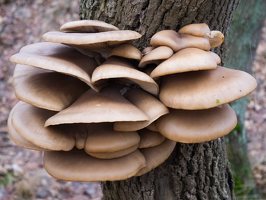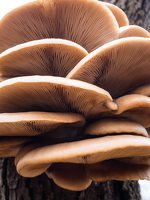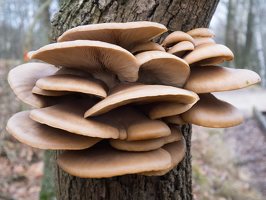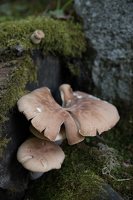- sort orderDefault
Photo title, A → Z
Photo title, Z → A
✔ Date created, new → old
Date created, old → new
Date posted, new → old
Date posted, old → new
Visits, high → low
Random
 home / Fungi · grybai / Pleurotaceae · kreivabudiniai / Pleurotus ostreatus · gluosninė kreivabudė
home / Fungi · grybai / Pleurotaceae · kreivabudiniai / Pleurotus ostreatus · gluosninė kreivabudė

Pleurotus ostreatus · gluosninė kreivabudė
https://en.wikipedia.org/wiki/Pleurotus_ostreatus The oyster mushroom is widespread in many temperate and subtropical forests throughout the world, although it is absent from the Pacific Northwest of North America. It is one of the more commonly sought wild edible mushrooms, though it can also be cultivated on straw and other media. While this mushroom is often seen growing on dying hardwood trees, it only appears to be acting saprophytically, rather than parasitically.
The mushroom has a broad, fan or oyster-shaped cap spanning 2–30 centimetres; natural specimens range from white to gray or tan to dark-brown; the margin is inrolled when young and is smooth and often somewhat lobed or wavy. The flesh is white, firm, and varies in thickness due to stipe arrangement. The gills of the mushroom are white to cream and descend on the stalk if present. If so, the stipe is off-center with a lateral attachment to wood. The mushroom's stipe is often absent. When present, it is short and thick. It has the bittersweet aroma of benzaldehyde (which is also characteristic of bitter almonds).
P. ostreatus is a carnivorous fungus, preying on nematodes by using a calcium-dependent toxin that paralyzes the prey within minutes of contact, causing necrosis and formation of a slurry to facilitate ingestion as a protein-rich food source.
Auga miškuose, parkuose, pakelėse, sodybose, ant negyvų, rečiau gyvų lapuočių, daugiusia rudenį, bet ir kitu metų laiku, net šiltą žiemą. Kepurėlė 5–12 cm skersmens, vėduokliška, pusiau apvali, sena – plokščia, mėsinga, paviršius lygus, pilkšva, violetinio atspalvio. Lakšteliai balti, seni – gelsvai pilki, platūs, nuaugtiniai, pakraštėliai nedantyti. Kotas 1–5 × 0,5–2,5 cm, ekscentrinis, kietas, baltas, gelsvas, gelsvai rusvas, plaušuotas. Trama neplona, balta, minkšta, sultinga, nekarti, miltų kvapo. Auga pavieniui, grupelėmis, kolonijomis. Vertingas valgomas grybas, daugelyje šalių (ir Lietuvoje) auginamas dirbtiniu būdu.



